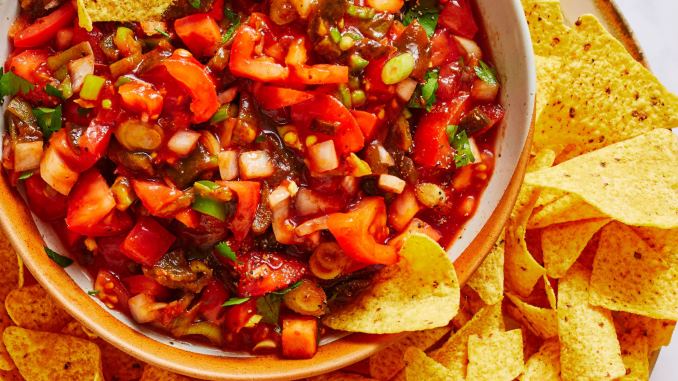Hot sauce and salsa are two of the most popular ingredients among international culinary connoisseurs. One is spicy and hot, while the other seems gentler.
So, salsa vs hot sauce, how to tell the differences between them, and which one do you prefer? We will compare these two spicy sauces in this article.
Quick Facts
Hot sauce:
- Texture: Thinner
- Ingredients: Mainly chilies and some hot seasonings
- Flavor: Hot and spicy
- Ways of use: Poured onto other meals
Salsa:
- Texture: Chunkier
- Ingredients: Cooked or uncooked, contain fruits and vegetables
- Flavor: Milder or sweeter
- Ways of use: Used as a dip
Related: My favorite list of Mexican foods
What Is Salsa?
Salsa is the Spanish term for sauce; therefore, it can apply to any sauce in various Spanish-speaking countries. However, many people connect salsa with a dip consisting primarily of diced tomatoes, peppers, and onions in the United States.
The ancient Aztecs recognized that the combination of chiles and tomatoes provided a delicious contrast to their main foods. To spice up the meal, add a little scoop of salsa to plates of corn and beans.
So, rather than a dip that’s consumed in large quantities, think of it as a well-balanced, delicious condiment to complement your other foods.
What Is Hot Sauce?
Vinegar, chili peppers, and salt are commonly used in hot sauce. In addition, fermentation is used in a lot of spicy sauces to give them a funky taste. For example, they might be in a paste or a liquid, appearing red, green, or brown.
Salsa Vs Hot Sauce Comparison
Texture
The distinction between these two types of sauces is that hot sauce has a thinner consistency, while salsa includes chunky tomato bits that give it its flavor.
Another distinction is that hot sauce is primarily red, with fiery red chilies and ripened tomatoes blended with other seasonings. In contrast, salsa is green and red, with chunky tomato bits for a rough texture.
Ingredients and flavor
Chili peppers are the foundation for many hot sauces, which can be as basic as adding vinegar and salt. Salsa may start with a foundation of vegetables or fruits and then add peppers to make them spicy.
Manufacturers utilize various methods to produce a particular taste, including aging in containers and heating the components. Other substances, such as mustard oil, can also create more heat for hot sauce.
Avocados, tomatillos, fresh green chiles, and lime juice are used in fresh salsas, whereas roasted tomatoes, seasonings, and dried red peppers are used in cooked salsas. Therefore, its taste may vary from being spicy to sweet, while the hot sauce is only spicy.
Ways of use
Hot sauces are thinner in texture and are typically tossed onto other meals, while salsas are chunkier and are typically used as dips, as seen with the chips described earlier.
Is Salsa A Sauce?
As mentioned before, salsa is, in fact, the Spanish term meaning sauce. Combined with diced tomatoes, onions, and peppers, it is meant to be used as a garnish or condiment, but it may also be mixed into a thick sauce-like texture if desired.
Customers may add as much salsa as they like to their tacos because it’s provided in sauce bottles.
What Is A Good Substitute For Salsa?
Pico de Gallo
Pico de gallo is a raw salsa containing finely diced onions, tomatoes, serrano chiles, cilantro, salt, and lime juices. It’s noted for its bright hues and light flavor.
Pico de gallo, unlike other varieties, has relatively little liquid, making it an excellent topping for quesadillas, tacos, and other Latin-inspired dishes. There are several variants of the classic Mexico pico recipe.
Jicama and oranges are used in some places to make salsa. Pico de gallo prepared with mango, watermelon, or cucumber is also available.
But one thing is clear. Pico de gallo is not traditionally thought of as a dip in Mexico. Instead, it’s used as a garnish on other meals or even as a salad.
Salsa de Aguacate
Avocado and tomato are used to make salsa de aguacate, a rich green sauce. The raw components are blended into a silky sauce that goes well with grilled meats and tacos. The freshness of avocado is balanced by the spice of serrano peppers in this sauce.
Salsa Roja
This type signifies “red sauce” in Spanish. It is a catch-all phrase for any tomato-based mixed red salsa.
Salsa Roja is made using raw, processed, or a mixture of both components. It can be blended until entirely slightly or smooth mixed for a lumpy texture.
What Makes Hot Sauce Hot?
Capsaicin is the molecule that gives chilies their characteristic spicy taste. Capsaicin was created by nature to prevent many creatures from eating chilies, but it has had the reverse effect since hot food is tasty.
Interesting fact! Many birds cannot detect the spiciness of capsaicin, which is how they can assist in spreading chili plant seeds by swallowing and releasing them.

